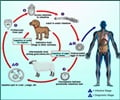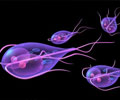A new American research may assist in providing defence against infections triggered by waterborne microscopic pathogen cryptosporidium.

It is also a potential bioterrorism agent.
Brandeis University biochemist Liz Hedstrom said: "All you need is a cow and a centrifuge to harvest enough oocysts to infect a small city."
Roughly 20 percent of calves are infected by cryptosporidium oocysts, which are found in their feces.
In 1993, in the largest waterborne disease outbreak in US history, this protozoan parasite infiltrated Milwaukee's municipal water supply, killing more than 100 people and sickening some 400,000.
Cryptosporidium invades the small intestine, where it opens fire, typically causing severe gastrointestinal distress and even death in people with weakened immune systems.
Advertisement
Hedstrom and her collaborators made a critical breakthrough in eroding cryptosporidium defenses when they identified IMPDH, a key enzyme involved in the biosynthesis of RNA and DNA, as a potential drug target.
Advertisement
Next, Hedstrom and her colleagues identified compounds that blocked the action of the Cryptosporidium IMPDH, but spared human IMPDH. Leading a large-scale screen of a commercial library containing 129,000 compounds, Hedstrom discovered more than fifty compounds that specifically inhibit the parasite enzyme.
A number of these compounds display antiparasitic activity. Hedstrom is now working on improving the compounds' potency, bioavailability and metabolic stability, a first step in the drug development process.
Hedstrom said: "It's a difficult problem, but we think that we have some very promising compounds."
Hedstrom discussed the research in her talk, titled "Targeting a prokaryotic protein in a eukaryotic parasite," at the American Society for Biochemistry and Molecular Biology's annual meeting on April 25.
Source-ANI
SAV













